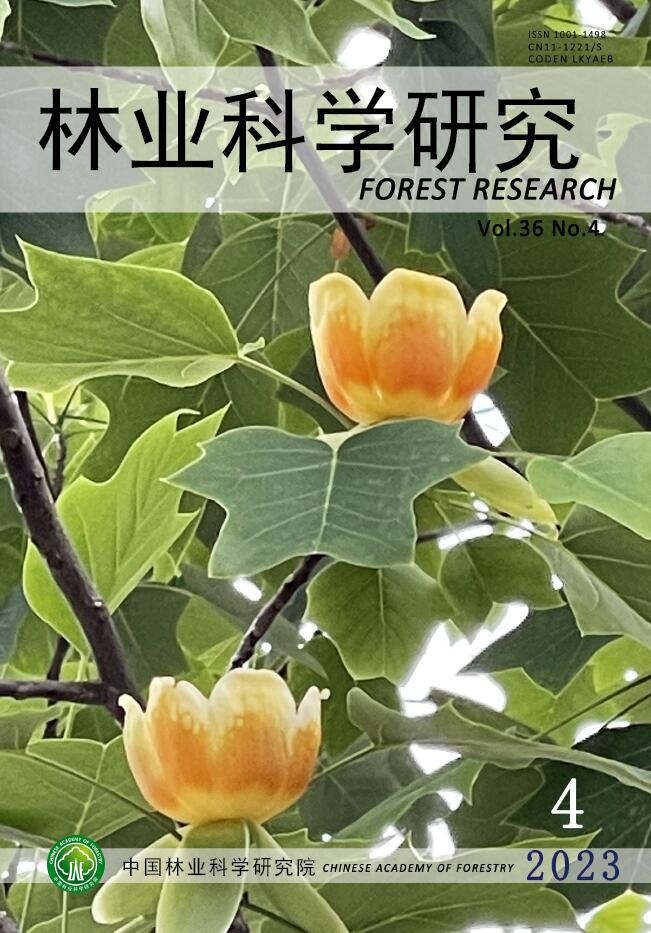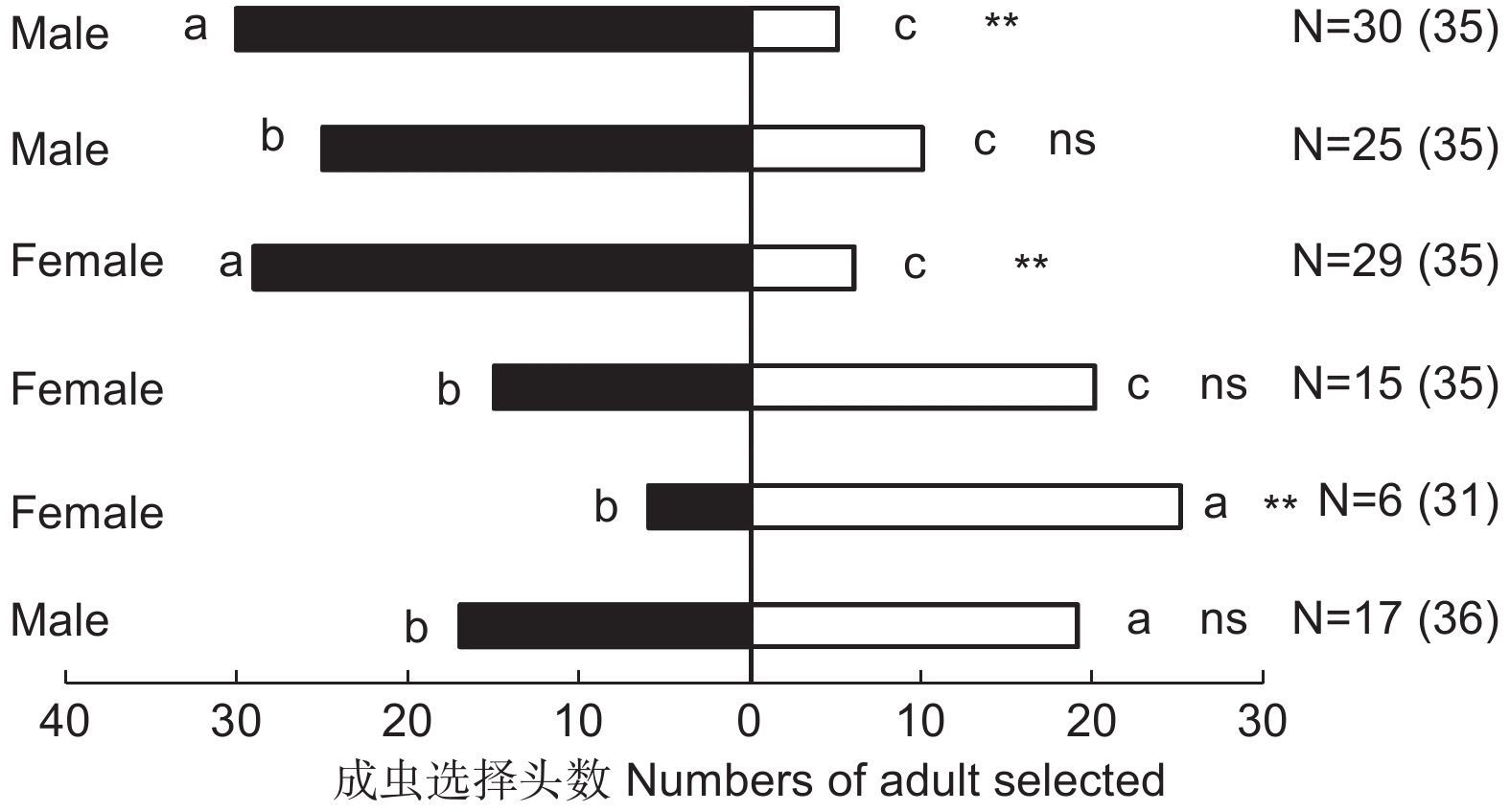-
光肩星天牛 (Anoplophora glabripennis) 属鞘翅目天牛科 (Coleoptera: Cerambycidae),是我国“三北”地区危害最为严重的蛀干害虫,也是重要的国际检疫害虫[1-2]。文献记录其在我国北方地区2~3 a 繁殖1代,老熟幼虫4—5月化蛹,成虫6—8月大量羽化,补充营养并交配产卵[3],但据我们实地调查,光肩星天牛在内蒙古磴口县1 a可以完成1代。
沙枣(Elaeagnus angustifolia L.)树高4~6 m,具有耐寒旱、盐碱和抗风沙特性,在我国主要分布于34° N以北和海拔1 500 m以下地区,是我国西北地区防风固沙和水土保持的主要树种[4-5]。沙枣可吸引光肩星天牛产卵,但其能流出树胶使天牛后代不能发育,因此被认为具有诱杀天牛的特性[6-7]。
我国西北地区土地干旱贫瘠、盐碱地多、风沙较大,很多树种不宜生存。新疆杨 (Populus alba var. pyramidalis)因其树体高大、干形通直、耐干旱、耐贫瘠,对光肩星天牛有一定的抗性,是目前西北地区二代防护林构建的主栽树种。长期单一栽植也使其受到天牛的危害,因此构建合理的混交防护林体系是实现虫害生态调控的必要手段[8]。目前常以合作杨(Populus simonii × P.pyramidalis cv‘Opera 8277’)、箭杆杨(Populus nigra var. thevestina)、复叶槭(Acer negundo L.)等作为诱饵树,加以化学农药和人工物理捕杀的方式来保护新疆杨免遭天牛危害[8-10],然而这种方式费时费力,如果对诱饵树处理不当反而成为虫源木。沙枣对光肩星天牛具有一定的诱杀特性,且侧根发达能生出很多根瘤提高土壤肥力,因此有研究者认为将沙枣与新疆杨间作可形成很好的防风沙林[11-13]。但沙枣对天牛的诱杀特性是否可对新疆杨起到较好的保护效果,目前尚不可知。本研究以沙枣和新疆杨为对象,结合室内、外试验评估了成虫对二者的选择性,为将来营造新一代抗虫农田防护林提供理论依据。
-
林间试验主要在内蒙古磴口县 (40°20' N,106°55' E)开展,该地为光肩星天牛疫区,新疆杨和沙枣大量栽植,取材方便。
春季砍伐受光肩星天牛危害的旱柳(Salix matsudana Koidz.)木段,运回后用石蜡将两端切口密封,然后将整个木段装入纱网袋内,置于阴凉室内。在成虫羽化季节每日收取新羽化的成虫,单头放入饲养盒(PE,22 cm × 17.5 cm × 12.5 cm)中,在磴口县用新鲜垂柳(Salix babylonica L.)枝叶饲喂,在河北大学实验室内用复叶槭枝叶饲喂。饲养温度保持在25 ℃, 相对湿度70%,待用。
-
Y型嗅觉仪的设置参考Ginzel等[14]并改进。经活性炭过滤后的空气流速0.6 L·min−1,经气味源和Y管每个臂的流速为0.3 L·min−1,气味源处设置50 g刚从树上剪下的沙枣或新疆杨枝叶(枝叶混合,未剪碎,枝叶比3:2),单选试验时以洁净空气作为对照,双选试验时则为沙枣vs新疆杨枝叶。实验装置均以特氟隆管连接。每次测试引入1头成虫,当成虫爬过Y臂的2/3处或落入陷阱球中认为做出选择,若在10 min中内没有做出选择,则更换试虫,每头试虫只测试1次,为保证统计分析的需求,本实验中作出选择反应的成虫数定为30~40头。每测试2头试虫转换1次左右臂,每测试4头试虫用丙酮清洗1次Y管,蒸馏水冲洗干净,电热风吹干冷却后使用。试验在每天8:30—17:30进行,室温23~26 ℃,照度为4.80 × 106 lux,且光源在位于测试的Y管正上方(非点状光源)。供试成虫为羽化饲养1周的成虫,未交配。
-
采用动态顶空吸附法收集沙枣和新疆杨挥发性化合物,参照陈友铃等[15]方法并加以改进:连续气流以500 mL·min−1的流速通过变色硅胶和活性炭后进入聚氟乙烯气体采集袋(袋内有8枝,大约长30 cm,粗1 cm,500 g左右,),然后携带植物挥发物进入玻璃吸附管(长13 cm,内径5 mm,200 mg Porapak Q吸附剂,80~100目,Waters Corporation,美国),抽提装置以特氟隆管连接成闭合回路,采集3 h。采集完成后用1 000 μL二氯甲烷(色谱纯,天津市科密欧化学试剂有限公司)淋洗吸附管中的提取物至4 mL棕色小瓶中,氮吹(100 mL·min−1)浓缩至200 μL,置于−20 ℃保存,用于后续的电生理试验和挥发物鉴定。
气相色谱-触角电位联用仪(GC-EAD)由配备了DB-WAX毛细管柱(30 m × 0.25 mm × 0.25 μm)的Agilent 7890A GC(美国)和EAG 记录操作系统(Syntech, 荷兰)组成。挑选触角完好、活力旺盛的雌性天牛成虫,剪下触角鞭节端部2节,用玻璃电极将触角两端固定,触角连接稳定后立即进样,同时打开记录系统采集电信号。进样口温度240 ℃,检测器温度300 ℃。手动进样1 μL,载气为高纯氮气,不分流进样。升温程序:起始温度40 ℃,保持2 min,以 5 ℃·min−1 的速率程序升温至160 ℃,保持2 min,最后以10 ℃·min−1的速率程序升温至200 ℃,保持2 min。
挥发物鉴定:将上述提取液进样气相色谱-质谱联用仪(GC-MS, 安捷伦7890B-7000C)进行分离鉴定。GC色谱柱为TG-WAX(30 m × 0.25 mm × 0.25 μm),进样口温度240 ℃,不分流进样。进样量与升温程序同上。MS条件:电子轰击离子源(EI)230 ℃,能量:70 eV;传输线温度为240 ℃;全扫描谱分析,扫描质量范围35~550 aum。
挥发物定量分析:化合物(Z)-3-己烯乙酸酯(Sigma-Aldrich有限公司,德国,纯度≥98%);(Z)-3-己烯醇(百灵威科技有限公司,中国,纯度≥98%);溶剂为二氯甲烷(天津科密欧试剂有限公司,中国,纯度99.5%)。将测试化学物分别稀释至1、5、10、50、100 ng·uL−1等5个标准溶液进行检测,可以绘制一条以浓度与响应色谱峰面积为变量的标准曲线,通过曲线回归方程即可算出引起电生理反应的挥发物浓度。
挥发性物质鉴定通过检索NIST14库(Scientific Instrument Services, Inc., Ringoes, NJ, USA),并进样标准化合物获得质谱图进行比对获得化合物定性结果,以外标法-标准曲线进行定量分析。
-
从林间截取高85 cm左右、直径12 cm左右的新疆杨和沙枣树干若干段,截面用石蜡密封保湿,置于阴凉室内待用,在48 h内完成下述接虫试验。
单选试验:取上述树皮完整无损的新疆杨或沙枣树干1段放入行为测试笼(1 m × 1 m × 1 m,不锈钢笼架,10目不锈钢网罩笼)底部中心点处直立,同时配置同树种枝叶(100 mL锥形瓶水培)为成虫提供营养(2 d更换1次)。在测试笼的对顶角引入相同日龄的性成熟成虫2♂5♀[16],每天记录木段上刻槽数、刻槽位置、刻槽时间等,10 d后取出成虫和木段,将木段用保鲜膜包裹,直立置于25 ℃室内。30 d后解剖刻槽,记录树段上的刻槽数、产卵数、死亡卵数、存活幼虫数和存活幼虫体质量(有效刻槽率/%=产卵刻槽数/刻槽总数 × 100,孵化率/%=孵化卵数/产卵数 × 100,存活率/%=幼虫存活数/产卵数 × 100)。每组设3个重复。
双选试验:试验方法同上,取新疆杨和沙枣木段各1段于测试笼底部对角线两端直立放置,在未放置木段的对角线顶角释放天牛成虫2♂5♀,每组设3个重复。
-
在林间选择健康、长势相近、胸径12 cm左右的新疆杨和胸径8 cm左右的沙枣各5棵(树龄一致,新疆杨长得快),分别编号,在每棵树的树干部位距离地面80~160 cm处套上纱网(10目),每个笼网内接入相同日龄的2♂5♀天牛成虫,笼内放置新鲜幼嫩枝条提供营养,每天更换枝条并检查试虫,若有成虫死亡立即更换相同日龄的新虫,10 d后取出试虫。30 d后,解剖刻槽部位,并记录每棵树上的刻槽数、产卵数、死亡卵数量、存活幼虫数、存活幼虫体质量。
-
成虫对2种枝叶的选择结果采用非参数检验(Pearson χ2)进行比较。采用独立样本T检验比较室内、外雌虫在沙枣与新疆杨树干刻槽产卵的差异性。采用软件IBM SPSS Statistics 26.0进行数据分析。
-
在单选试验中(图1),雄虫对沙枣枝叶的选择数为30头,与对照相比存在极显著差异(χ2=10.411, P<0.01);对新疆杨枝叶的选择数为25头,与对照相比差异不显著(χ2=3.238, P>0.05)。雌虫对沙枣枝叶的选择数为29头,与对照相比存在极显著差异(χ2=8.584, P<0.01);对新疆杨枝叶的选择数为15头,与对照相比无显著差异(χ2=0.689, P>0.05),以上每组选择中未作出选择的试虫数均未超过5头。

Figure 1. Behavioral responses of Anoplophora glabripennis adults to different plant odors in Y-tube olfactometer
在双选实验中(图1),雄虫选择沙枣枝叶19头,选择新疆杨枝叶17头,未作出选择4头,雄虫对于二者选择无显著性差异(χ2=0.191,P>0.05);雌虫选择沙枣枝叶25头,选择新疆杨枝叶6头,未作出选择4头,雌虫选择沙枣枝叶气味的成虫数占作出选择成虫数的80.65%(χ2=8.533,P<0.01)。
-
经GC-MS共鉴定新疆杨枝叶挥发物28种,其中酮类3种、酚类2种、醇类2种、酯类7种、醛类5种和烃类9种;从沙枣枝叶共鉴定出15种化合物,其中芳香类1种、烯类3种、醛类2种、酯类5种、醇类3种和酚类1种。二者相同种类的化合物共有6种,分别是:2-已烯醛、乙酸己酯、乙酸叶醇酯、顺-3-己烯基丁酯、叶醇和水杨酸甲酯。
由于主要关注雌虫的产卵选择性,因此本研究只对雌虫开展了触角电位试验。通过GC-EAD检测发现新疆杨释放的叶醇(cis-3-Hexen-1-ol)和乙酸叶醇酯(cis-3-Hexenyl acetate)可引起雌虫的触角电生理反应。沙枣挥发性物质中3-蒈烯(3-carene)、乙酸叶醇酯和叶醇可引起雌虫触角电生理反应。上述引起光肩星天牛触角反应的物质在含量及比例上存在着明显的差异。经计算,新疆杨枝叶挥发性物质中乙酸叶醇酯为2 640.1 ng·min−1、叶醇520.84 ng·min−1;沙枣枝叶挥发性物质中乙酸叶醇酯为2 227.44 ng·min−1、叶醇196.05 ng·min−1;沙枣和新疆杨中乙酸叶醇酯之比为1 : 1.19,叶醇之比为1 : 2.66。上述物质的种类和含量不同,引起的电信号刺激的强弱程度也不相同,叶醇的电生理反应强于乙酸叶醇酯。
-
在单选实验中,成虫分别在新疆杨和沙枣树干上的刻槽数量没有显著差异(t=−2.500, df=4, P>0.05);但有效刻槽率具显著性差异(t=3.162, df=4, P<0.05),沙枣树干上的有效刻槽率较低;沙枣树干上的卵孵化率低于新疆杨树干(t=25.166, df=4, P<0.001);幼虫存活率无显著性差异(t=0.069, df=4, P>0.05);幼虫体质量有极显著性差异(t=−3.499, df=15, P<0.01)(见表1)。
方法
Method树种
Tree species平均刻槽数
Average number of
egg niche有效刻槽率
Percent of
effective egg niche/%孵化率
Egg hatching
rate/%幼虫存活率
Survival rate of
larvae/%存活幼虫体质量均值
Average weight of
living larvae/mg单选 Single choice P 8.33±1.53 a 75.00±5.00 a 100±0 a 52.67±0.09 a 51±18 b E 15.00±4.36 a 58.33±7.64 b 57.33±2.94 b 51.90±0.17 a 81±16 a 双选 Double choice P 4.67±1.15 a 72.23±4.79 a 100±0 a 78.63±18.55 a 54±22 a E 18.00±1.73 b 58.90±10.31 a 65.43±8.49 b 53.73±15.86 a 81±31 b 注:数据为平均值±标准误;P代表新疆杨,E代表沙枣;同列不同小写字母表示差异显著(P<0.05),下同
Notes: Data are means±standard error (SE); P, represents P. alba. var. pyramidalis, E, represents E. angustifolia; Different letters in the same column mean significant difference at 0.05 level. The same belowTable 1. Oviposition experiments of Anoplophora glabripennis on stems of Elaeagnus angustifolia and Populus alba. var. pyramidalis in laboratory
双选实验中,成虫在沙枣树干上的平均刻槽数(18 ± 1.73)远多于新疆杨(4.67 ± 1.15)(t=−11.094, df=4, P<0.01);新疆杨上的有效刻槽率略多于沙枣,但不显著(t=2.032, df=4, P>0.05);新疆杨树干上的卵孵化率显著高于沙枣(t=7.053, df=2, P<0.05);幼虫存活率没有显著性差异(t=1.767, df=4, P>0.05);沙枣上的幼虫体质量显著大于新疆杨上的幼虫体质量(t=−2.116, df=23, P<0.05)。
-
在林间套笼情况下,天牛成虫在新疆杨和沙枣树上的平均刻槽产卵数没有显著差异(t=-0.758, df=6, P>0.05)(表2),但幼虫在新疆杨上的存活率显著高于在沙枣树上的存活率(t=17.837, df=2, P<0.01),说明沙枣树不适合光肩星天牛幼虫存活。
树种
Tree
species平均刻槽产卵数
Average number of
egg niche per tree幼虫存活率
Survival rate of
larvae/%存活幼虫平均体质量
Average weight of
living larvae/mgP 33.67±4.72 a 48.67±4.72 a 37.00±5 a E 36.00±3.94 a 0 b 0 b Table 2. Oviposition of Anoplophora glabripennis adults on Elaeagnus angustifolia and Populus alba. var. pyramidalis in the field
-
植物挥发物对植食性昆虫定位寄主进行取食或产卵起着至关重要的作用[17],天牛类昆虫主要通过嗅觉感知寄主树木[18-20]。在光肩星天牛成虫对新疆杨和沙枣枝叶气味的双向选择实验中,雌虫明显喜欢沙枣枝叶气味,而雄虫对于二者的偏好性不大(图1)。两树种挥发性物质的鉴定及雌虫触角电生理反应结果显示(图2),3-蒈烯、乙酸叶醇酯和叶醇可引起雌性触角电生理反应,其中3-蒈烯只在沙枣挥发性物质中检测到。不同树木引起成虫触角电生理反应的挥发物种类和含量上的差异,可能是光肩星天牛成虫远距离识别不同寄主的依据[21]。

Figure 2. Gas chromatography-Electroantennographic detection of Anoplophora glabripennis to leave volatiles of Elaeagnus angustifolia or Populus alba. var. pyramidalis
前人研究表明,光肩星天牛对寄主植物复叶槭的挥发性化合物叶醇和乙酸叶醇酯有触角电位活性,且对成虫具有较强的引诱作用[22-24],这与我们的研究结果一致,而不同化合物释放的量及比例不同,是导致成虫对不同寄主存在选择性差异的主要因素。
光肩星天牛的刻槽产卵数量和幼虫存活率是评估天牛种群数量增长趋势的重要指标。在室内天牛刻槽产卵实验中,天牛偏好选择在沙枣上产卵,但在新疆杨上的有效产卵率高于沙枣(表1)。对于沙枣上有效产卵率低的原因,笔者认为是天牛刻槽行为多于产卵行为。由于刻槽孔被流胶覆盖难以辨别是空刻槽还是产卵刻槽,因此人们一直误认为流胶的刻槽孔就是产卵孔。林间套笼试验中,天牛在二者上的平均刻槽产卵数无显著差异,但幼虫在沙枣上均未成活(表2)。对于室内试验中沙枣树干上天牛幼虫存活而林间沙枣树干上的幼虫均未成活的现象,笔者认为沙枣活立木上的次生代谢分泌物(沙枣胶)是杀死天牛卵或新孵化幼虫的主要原因[6],室内沙枣树干由于已离体并丧失分泌胶体的功能,天牛幼虫因而存活下来。沙枣胶的成分主要为杂多糖聚合物[25],但沙枣树产生沙枣胶的机理尚不清楚,沙枣胶是否可用于天牛防治还有待进一步研究。室内沙枣木段内光肩星天牛幼虫的平均体质量显著高于新疆杨木段,说明沙枣树在没有沙枣胶分泌的情况下其营养成分完全满足天牛幼虫生长发育的需求,但具体是那些营养成分,尚不可知。从本结果也可以得出,沙枣树干上除沙枣胶以外的其他次生代谢物对天牛的生长发育无明显阻碍作用。
另外,作者在天牛疫区开展的林间调查结果与本实验结果基本一致:天牛在沙枣树干上刻槽产卵后极少有羽化孔出现。调查过程中常可见到天牛成虫在沙枣枝叶上取食的现象,笔者认为沙枣能够吸引光肩星天牛的主要原因是沙枣枝叶能很好的为天牛提供必需的营养物质,而沙枣枝叶对天牛的这种强引诱性,可以代替在西北地区长势不好的复叶槭作为光肩星天牛的引诱树种[26],由于其树高较矮,可以在成虫羽化季节于沙枣枝叶上喷施绿色无公害农药杀灭天牛成虫。沙枣活立木上的天牛后代不能存活,因此沙枣树基本符合诱杀树的特征,但是否能真正起到降低天牛种群密度的效果还需进一步深入研究。
-
光肩星天牛成虫偏爱沙枣枝叶,其释放的3-蒈烯、乙酸叶醇酯和叶醇均可引起雌性天牛触角的电生理反应。在室内双选试验中,天牛雌虫于沙枣树干上的刻槽数显著多于在新疆杨树干上的刻槽数,但雌虫无论在室内还是林间的单选试验中在两种树木上的刻槽数量均不具有显著差异。结果显示,光肩星天牛在沙枣上的有效产卵率较低,且后代在沙枣活立木上不能完成生长发育。
Preference of Anoplophora glabripennis to Populus alba var. pyramidalis and Elaeagnus angustifolia
- Received Date: 2022-12-02
- Accepted Date: 2022-12-22
- Available Online: 2023-08-20
Abstract:






 DownLoad:
DownLoad:
